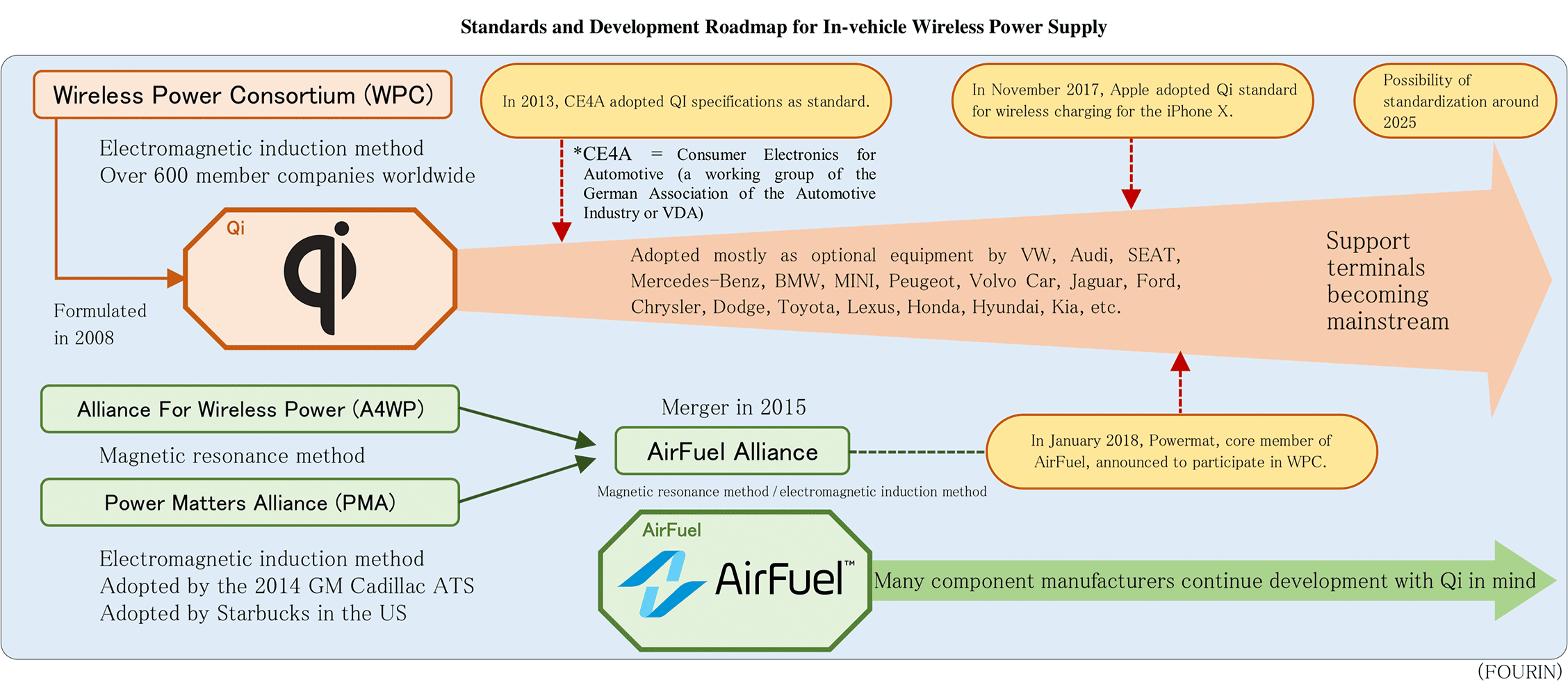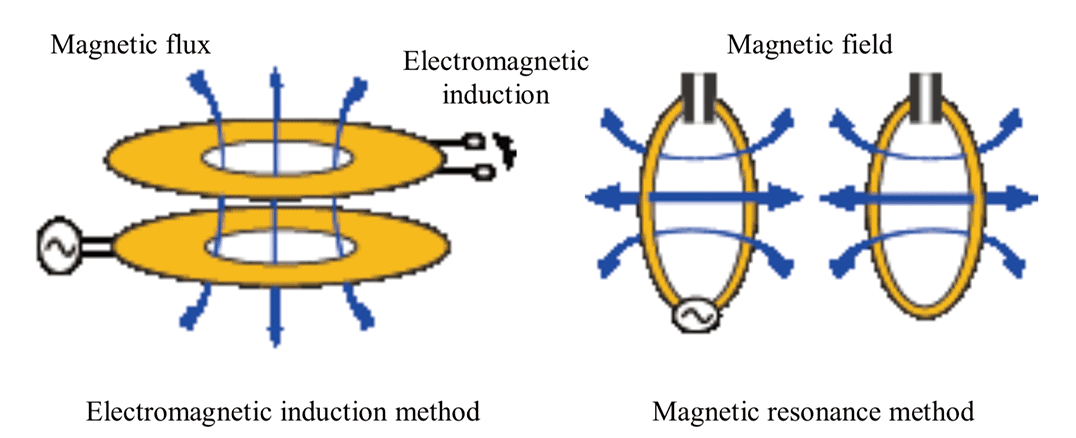AAA weekly
2020-01-27
Copyright FOURIN, Inc. 2025
Rohm, STMicroelectronics’ Integrated Solution for In-vehicle Wireless Power Supply
Wireless power supply technology improves safety, waterproof and dustproof features because the connector is not exposed to outside elements. Although the charging efficiency is inferior to that of wired power supply, there are significant benefits to users, such as reduced labor, gradually becoming popular in the area of home appliances.
On the other hand, adoption in the automotive sector is limited to some high-end models mostly as optional equipment. The area near the center console, which is suitable for wireless power supply, is a hot spot that other devices, such as onboard infotainment operation switches, also want to occupy. It is difficult to provide valuable positions just for wireless charging. In response to these challenges, Rohm and STMicroelectronics jointly announced a Qi-compliant wireless power solution for Near Field Communication (NFC) in January 2019. This is a revolutionary solution that can simultaneously supply wireless power while maintaining the NFC communication function that allows pairing with in-vehicle infotainment. Rohm was in charge of the design of the wireless power supply Qi and the internal board, and STMicroelectronics was responsible for the microcomputer and NFC communication.
The Qi standard has been adopted by European automakers since the European automotive consumer electronics standard organization Consumer Electronics for Automotive (CE4A) adopted it in 2013. In addition, some European automakers have begun using NFC-enabled smartphones to open and close doors, and there has been growing demand for technology that enables wireless charging and NFC communication to be implemented simultaneously in automobiles. This announcement responds to such needs and aims for mass-manufacturing it in 2-3 years. The two companies are focusing not only on European automakers, but also on Japanese automakers who have been reluctant to use in-vehicle wireless charging.
The new solution is not limited to coordination with in-vehicle infotainment through NFC pairing, but can be also used in various ways in the future, such as opening and closing doors, starting the engine, charging systems such as ETC and personal authentication in shared cars. Furthermore, the spread of this technology is likely to further accelerate the trend of using mobile terminals such as smartphones instead of car keys.
Overview of Development Status and Main Methods of In-vehicle Wireless Power Supply

Qi
・Qi is an international standard for wireless power supply established in 2008 by the Wireless Power Consortium (WPC). – It is a wireless power supply standard of the electromagnetic induction type that transmits electric power using induction magnetic flux generated between a power transmission side and a power reception side. – Transmitting and receiving power started at a maximum of 5W, and has been expanded to a maximum of 15W under the latest standard Qi 1.2. – The origin of the name is the Chinese character for “energy flow” and pronounced “chi.”Qi and rival standard AirFuel
・For wireless power supply of small terminals, another standard body called the AirFuel Alliance was launched in 2015. – A new organization was formed by the merger of the Alliance For Wireless Power (A4WP) and the Power Matters Alliance (PMA), which were promoting wireless power supply technology. – It has a high market share in North America. GM announced in 2011 that it would use wireless power pads made by Powermat, the core company of PMA (later AirFuel). GM’s Cadillac ATS, launched in 2014, has adopted the device. US coffeehouse chain Starbucks also offers Powermat’s power pads to its customers. ・Meanwhile, Consumer Electronics for Automotive (CE4A), a European consumer electronics standard organization, announced in 2013 that it would adopt Qi specifications. Around this time, automakers that set Qi wireless charging pads as options on center consoles and other devices increased. – CE4A is a technical committee under the German Association of the Automotive Industry (VDA) and has a particularly strong influence on automakers. ・Apple's iPhone X, launched in November 2017, has adopted the Qi wireless charging standard. ・Powermat, a key member of AirFuel, announced in January 2018 that it would join WPC. Powermat is currently developing products that comply with both AirFuel and Qi specifications. ・As of March 2019, Qi-compliant products, with a focus on smartphones and tablets, had an overwhelming share of over 90% in the wireless power market.Magnetic resonance method and electromagnetic induction method
 ・Qi uses electromagnetic induction as standard method, and AirFuel uses both electromagnetic induction and magnetic resonance as standard methods.
・Looking at the electromagnetic induction method, a primary coil is arranged on the power transmission side and a secondary coil is arranged on the power reception side. When a high-voltage current is supplied to the primary coil, a magnetic flux is generated. Meanwhile in the secondary coil, an induced electromotive force is generated to cancel the magnetic flux. This induced electromotive force is used for charging the device.
– Transmission efficiency is higher than magnetic resonance. It also has a simple design.
・The magnetic field resonance method utilizes a phenomenon in which a current flows through a power transmission side coil and vibration of a generated magnetic field is transmitted to a resonance circuit of the power reception side coil at the same frequency.
– It has a high-degree of spatial freedom and multiple power-receiving devices can be charged with one transmitter pad. Furthermore, the amount of heat stored in nearby metals is small.
(Created using PR materials of WPC, CE4A, AirFuel, Rohm and TDK as well as various media sources)
・Qi uses electromagnetic induction as standard method, and AirFuel uses both electromagnetic induction and magnetic resonance as standard methods.
・Looking at the electromagnetic induction method, a primary coil is arranged on the power transmission side and a secondary coil is arranged on the power reception side. When a high-voltage current is supplied to the primary coil, a magnetic flux is generated. Meanwhile in the secondary coil, an induced electromotive force is generated to cancel the magnetic flux. This induced electromotive force is used for charging the device.
– Transmission efficiency is higher than magnetic resonance. It also has a simple design.
・The magnetic field resonance method utilizes a phenomenon in which a current flows through a power transmission side coil and vibration of a generated magnetic field is transmitted to a resonance circuit of the power reception side coil at the same frequency.
– It has a high-degree of spatial freedom and multiple power-receiving devices can be charged with one transmitter pad. Furthermore, the amount of heat stored in nearby metals is small.
(Created using PR materials of WPC, CE4A, AirFuel, Rohm and TDK as well as various media sources)

